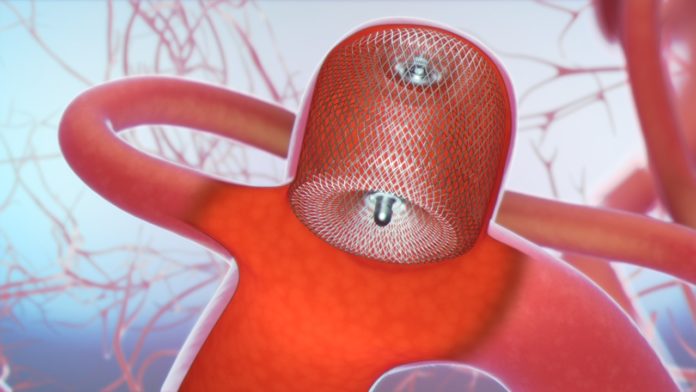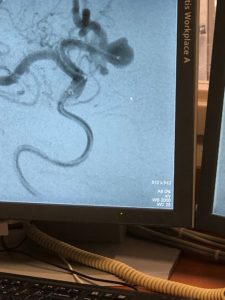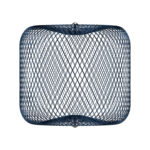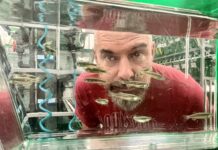
After learning she had a family history of brain aneurysms, Mary Steinhilber went in for testing to see whether she also had an aneurysm.
Doctors found she had not one, but three. Robert James, MD, a neurosurgeon at UofL Physicians – Neurosurgery, treated two of her aneurysms with minimally invasive stents, but the location of the third, at a juncture of arteries, was not conducive to stent treatment.
In January, the U.S. Food and Drug Administration approved the WEB Aneurysm Embolization System for treating this type of aneurysm, and on Feb. 13, Steinhilber was one of the first three patients in Kentucky to be treated with the device at UofL Hospital.
An aneurysm is an enlarged, weakened area of an artery that results in a bulging or ballooned area in the artery. Untreated, an aneurysm in the brain may rupture, causing severe disability, cognitive loss or death. The WEB system, James said, provides a new, minimally invasive option for treating wide-necked bifurcation aneurysms, which occur at the juncture of two arteries. In the procedure, a mesh basket is placed inside the aneurysm, allowing blood to bypass the opening, which seals itself off over time, creating a permanent cure.

“If we can fix the aneurysm before it bursts and cure it, then the threat of this aneurysm bursting and the patient dying from it essentially goes away,” James said. “The WEB device is a game changer for the minimally invasive treatment of aneurysms.”
Steinhilber is grateful to have more advanced options for treating her condition. Two of her sisters were treated for aneurysms in the past. One required re-treatment and another was unable to be treated for one aneurysm due to its location. A third sister died suddenly from what may have been a ruptured aneurysm.
“Seeing the history of my sisters, I feel very good about what the UofL doctors are doing here,” Steinhilber said. “It’s wonderful to see the progress made in treating aneurysms.”
As many as 6 million people in the United States are estimated to have an unruptured brain aneurysm. Coils and stents have provided minimally invasive options for some types of aneurysms, but James explained those options have limitations in their use, and may have negative features.
The WEB (an acronym for Woven Endo-Bridge) device is approved for treating wide-neck bifurcation aneurysms, which may account for 35 percent of all brain aneurysms. James completed the first three procedures in Kentucky with the device since it received FDA pre-market approval on Jan. 7. He had previous experience in performing the procedure, having participated in the device’s clinical trials.

During the WEB system procedure, a small catheter is threaded from the groin area through the patient’s artery to the aneurysm site. Using fluoroscopy imaging, the surgeon deploys the WEB device into the “sack” of the aneurysm, where its flexible mesh conforms to the aneurysm walls, minimizing blood flow inside the aneurysm. In most cases, over time, the body seals off or occludes the neck of the aneurysm, essentially curing it.
In clinical testing, the WEB system was shown to be highly effective and safer than other options. In addition, the minimally invasive nature of the procedure means most patients, including Steinhilber, are able to go home the next day.
In addition to unruptured aneurysms, the WEB system may be used in some cases in which the aneurysm has already ruptured, providing more desirable options for treatment.
“This device also gives us the ability to use flow diversion in already ruptured bifurcation (branch point) aneurysms to prevent them from re-rupturing, which we have never been able to do before,” James said.

The WEB system, marketed by MicroVention, Inc., a U.S.-based subsidiary of Terumo and a global neurovascular company, has been used safely in more than 6,000 cases outside the United States as well as clinical studies here and abroad.



































